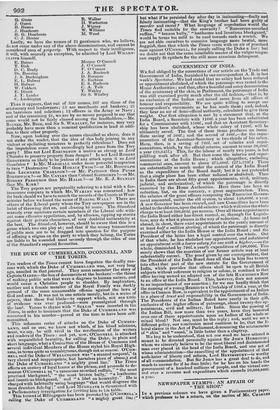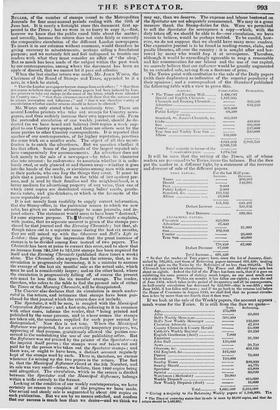NEWSPAPER STAMPS: AN AFFAIR OF "THE SHOP?
IN a previous column we have given a Parliamentary paper, which professes to be a return, on the motion of Mr. CHARLES
Bums% of the number of stamps issued to the Metropolitan Journals for four semi-annual periods ending with the 30th of June last. It is nearly a fortnight since this document first ap- peared in the Times ; but we were in no hurry to copy it,-first, because we knew that the public cared little about the matter ; and secondly, because the return does not state fairly or correctly the comparative circulation of the different London newspapers. To insert it in our columns without comment, would therefore be giving currency to misstatements, perhaps aiding a fraudulent purpose; and we certainly felt and feel indisposed to trouble our readers with what they must consider an affair of "the shop." But so much has been made of the subject within the past week by our contemporaries, among whom the document has been an apple of discord, that we cannot let it pass sub silentio.
When the last similar return was made, Mr. JOHN Woon, the Chairman of the Board of Stamps and Taxes, appended to it a note, in which he stated, " That the London newspapers borrow stamps from each other; " " that there was mason to believe that agents of Country papers had been induced by Lon- don printers to take out stamps in the name of the latter, which were intended for Country use ; " " that those circumstances will show that the returns must. be always Incomplete and fallacious;" and " that it was therefore worthy ot considecation whether similar returns should in future be allowed."
Mr. WOOD only stated what is notoriously true. There are several London printers who take out stamps for Country news-
papers, and thus unfairly increase their own apparent sale. From the pretended circulation of one weekly journal, should be de- ducted (as we have heard and believe) 3000 copies a week sup- plied to one Country newspaper, and there are others sent by the same parties to other Country correspondents. It is reported that another of our contemporaries, of far higher reputation, practises the same trick on a smaller scale. The object of all this mysti-
fication is to catch the advertisers. But we question whethe.: it has that effect. Some of the journals of the largest reputed sale
have comparatively few announcements. An advertiser does not look merely to the sale of a newspaper-he takes its character also into account : he endeavours to ascertain whether it is sedu- lously read, or only glanced at and thrown away-whether it goes into the hands of the needy, or circulates among men with money in their pockets, who can buy the things they covet. It must be plain that a journal which lies on the table of 500 opulent per- sons, and is read by their families and the neighbourhood, is a better medium for advertising property of any value, than one of
which 5000 copies are distributed among ladies' maids, gentle- men's valets, and gin-drinkers, or which is the favourite of the more reputable poor.
It is not merely from inability to supply correct information, that the Stamp-office, in the particular return to which we now refer, has given an undue advantage to some journals, and in- jured others. The statement would seem to have been "doctored,' fa some express purpose. T6 I Morning Chronicle complains, with justice, that no separate account is given of the stamps pur- chased for that journal and the Evening chronicle; but that, al- though taken out in a separate name during the last six months, they are still mixed up with the Observer and Bells Life in London ; thus giving the impression that the great increase of stamps is to be divided among four instead of two papers. The Chronicle has been at pains to correct this error, and to show that an increase from 324,500 to 953,500 stamps has been required for itself and the Evening Chronicle (published three times a week) alone. The Chronicle also argues from the returns, that, as its circulation is progressively increasing, it is a mistake to assume the average of the last six months' sale as the actual sale, which must be and is considerably larger; and on the other hand, where the circulation is progressively falling off, of course the present sale must he less than the six months' average. The reader, therefore, who refers to the table to find the present sale of either the Times or the Morning Chronicle, will be disappointed.
The Courier also declares that its circulation is much under- rated in the return, and intimates that stamps have been pur- chased for that journal which the return does not include.
The Spectator, it will be seen, is coupled with the Municipal Corporation Reformer ; and a foot. note, referring to it in common with other cases, informs the reader, that "being printed and published by the same persons, and in whose names the stamps are taken out, the numbers supplied for each paper cannot be distinguished." Now this is not true. When the Municipal Reformer was projected, for an avowedly temporary purpose, we, approving of that purpose, gratuitously allowed the parties con-
cerned in the undertaking the use of our publishing-office. But the Ref or.nierwas not printed by the printer of the Spectator-as the imprint itself proves ; the stamps were not taken out and
paid for by the person who takes out the Spectator stamps ; and there was, or ought to have been, a distinct account regularly kept of the stamps used by each. There is, therefore, no excuse whatever for mixing up the two papers in the return. The fact !s, that the Municipal Reformer closed at the 5th Number, and its sale was very small-fewer, we believe, than 1000 copies being sold altogether. The circulation, which in the return is divided between the Spectator and the Municipal Reformer, belongs within a trifle entirely to the former. Looking at the condition of our weekly contemporaries, we have certainly no reason to complain of the progress we have made. Our actual and steady sale is augmented by about 400 copies on each publication. But we are by no means satisfied, and confess that our success is much less than we desire-and we think we
may say, than we deserve. The expense and labour bestowed on the Spectator are not adequately remunerated. We may in a great measure thank the Stamp-duties for this. Were we permitted to sell the Spectator for sevenpence a copy-which, with the duty taken off, we should be able to do-our circulation, we have reason to believe, would be perhaps trebled. To be candid, how- ever, we do not suppose that we should have many more readers. Our expensive journal is to be found in reading-rooms, clubs, and public libraries, all over the country : it is sought after and bor- rowed by many who would buy it at sevenpence. Therefore, although it would be exceedingly agreeable to reap a reasonable and fair remuneration for our labour and the use of our capital, we scarcely believe that our influence would be greatly augmented by an extended sale, arising from a decrease of price.
The Tories point with exultation to the sale of the Daily papers (with their duplicates) as indicative of the superior popularity of their opinions ; and a correspondent of the Standard published the following table with a view to prove this.
MORN INS.
* The Times and Evening Mail Herald and English Chronicle
CullS,..VatiVe.
1,406,l197 1,187,005 Destructive.
Chronicle and Evening Chronicle
953,500
Advertiser 642,230 367,000 Post
Public Ledger 63,500
EVENING.
Standard, St. James's Chronicle, &e 863,000
Globe
483,000
Sou 395,000
Courier 247,000 True Sun and Weekly True Sun
229,000 Albion 130,000
4,024,302 2,949,750
2,949,750
Total majority in favour of the
'onservative press ......
1,074,732
It will be seen that the ratting of the Times, all of whose readers are presumed to be Tories, turns the balance. But the Sun put the matter in a different light, by a statement of the increase and decrease of sale of the different papers.
TORE PAPERS.
Times Herald
For the last Itierease.
Half-year. Decrease. 200,502 142,995
9,000
Public Ledger .......... . 2,000
Standard, &c. 113,132
Albion 7,000 2
131,132 043,497 Deduct Increase
151,13'2 Total Decrease
192,365
EFORMING PA PERS.
Chronicle 629,000
Aden User 47,450
Globe
21,000 102,000 Sun
Coutier
26,000
True Sun 40,000
773,450 87,000 Deduct Decrease 87,000
Total Increase... 691,450
" So that the readers of Tory papers have, since the 1st of January, dimi- nished by 192,363, and those of Reforming papers increased 691,450; making a total of gain on the Tories by the Reformers of no less than 883,815. The Chronicle has trebled its circulation. The Times and Herald have each lost about an eighth. Indeed the fall of the Times has been such, that if it goes on exhibiting the same powers of sinking much longer, no one need much care what side it takes. Within six months it has fallen one eighth ; since the end of June 1834, which takes in the period of its apostacy and all its consequences, its half-yearly circulation has decreased by 352,000-that is one-fifth ; since June 1833, it has fallen still more ; and if we go back to the returns laid before the House of Commons in August 1833, we shall find that its present circula- tion is less by more than one-fourth than it then was."
If we look at the sale of the Weekly papers, the account appears much worse for the Tories. It is still from the Sun we quote-
Tory. Reforming.
Age 275,000 Atlas s Weekly Messenger 308,5Bell's
60,000
Bell's New Weekly Messenger
133,000
Christian Advocate County Chronicle & County Herald 47,100 657:100
000 Cobbetes Weekly Register
28,250 7,000 English Gentleman (dead)
Examiner John Bull
91,300 128,000 News
38,750 Observer, &c.
452,125 107,000 Ohl England, &c
Patriot -- '75,000 Record 123,000
Sunday Times - 200,000 Sunday Herald - 44,775 Spectator
63,000 Satirist
83,000 Watchman (Methodist)
70,000
Weekly Dispatch
815,000 New Weekly Dispatch (dead)
16,000
Total 1,023,500 2,212,300
"Giving a majority to the Reforming Weekly papers of 1,188,800. The • The Times of yesterday states that its sale is more by 50,000 copies, and that the return should be 1,456,997. 'Tett majority on the Daily papers was 1,074.752. So thit the result on the whole number of London papers gives a majority of II4,048 on the half-yearly roirculation to the Reforming side. But for the defalcation of the Times, it would have been neatly two millions !"
Thus, if the comparative circulation of the Metropolitan jour- nals is to be taken as an index of public opinion, the Tories will be found in a minority ; and if the inquiry be extended to the provincial journals, the result will be still more unsatisfactory to the Obstructives.
In conclusion, we ought to add, that although the returns on which the above remarks and calculations are founded, are fre- quently moved for in order to favour the interest or to promote the fraudulent designs of some particular journal, yet in the present instance we entirely acquit the mover, Mr. CHARLES DULLER, of being a party to any such trick. We believe he wished to prove, that, in spite of its repeated assertions to the contrary, the circulation of the Times had been very much re- duced in consequence of its ratting to the Tories ; and that there- fore no argument in favour of the popularity of Tory ism could be founded on the fact of Tory opinions being advocated by ties (formerly) sagacious conductors of that paper. The motive of Mr. BULLER was fair and justifiable, though the result of his motion has been partial injustice.




























 Previous page
Previous page